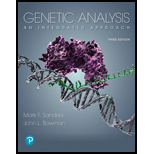
Genetic Analysis: An Integrated Approach (3rd Edition)
3rd Edition
ISBN: 9780134605173
Author: Mark F. Sanders, John L. Bowman
Publisher: PEARSON
expand_more
expand_more
format_list_bulleted
Concept explainers
Textbook Question
Chapter 4, Problem 20P
Brachydactyly type D is a human autosomal dominant condition in which the thumbs are abnormally short and broad. In most cases, both thumbs are affected, but occasionally just one thumb is involved. The accompanying pedigree shows a family in which brachydactyly type D is segregating. Filled circles and squares represent females and males who have involvement of both thumbs. Halffilled symbols represent family members with just one thumb affected.

a. Is there any evidence of variable expressivity in this family? Explain.
b. Is there evidence of incomplete penetrance in this family? Explain.
Expert Solution & Answer
Want to see the full answer?
Check out a sample textbook solution
Students have asked these similar questions
Other than oil and alcohol, are there other liquids you could compare to water (that are liquid at room temperature)?
How is water unique compared to these other liquids?
What follow-up experiment would you like to do, and how would you relate it to your life?
Selection of Traits
What adaptations do scavengers have for locating and feeding on prey?
What adaptations do predators have for capturing and consuming prey?
Competition Between Species
What natural processes limit populations from growing too large?
What are some resources organisms can compete over in their natural habitat?
Chapter 4 Solutions
Genetic Analysis: An Integrated Approach (3rd Edition)
Ch. 4 - 1. Define and distinguish incomplete penetrance...Ch. 4 -
2. Define and distinguish epistasis and...Ch. 4 - When working on barley plants, two researchers...Ch. 4 - Fifteen bacterial colonies growing on a complete...Ch. 4 - 5. In a type of parakeet known as a “budgie,”...Ch. 4 - 6. The and blood groups are given below for four...Ch. 4 - The wild-type color of horned beetles is black,...Ch. 4 - 8. Two genes interact to produce various...Ch. 4 - Prob. 9PCh. 4 - 10. In rats, gene produces black coat color if the...
Ch. 4 - 11. In the rats identified in Problem, a third...Ch. 4 - Using the information provided in Problems 10 and...Ch. 4 - 13. Total cholesterol in blood is reported as the...Ch. 4 - 14. Flower color in snapdragons results from the...Ch. 4 - 5. A plant line with reduced fertility comes to...Ch. 4 - Prob. 16PCh. 4 - The coat color in mink is controlled by two...Ch. 4 - Prob. 18PCh. 4 - 19. Feather color in parakeets is produced by the...Ch. 4 - Brachydactyly type D is a human autosomal dominant...Ch. 4 - 21. A male and a female mouse are each from...Ch. 4 - Xerodermapigmentosum (XP) is an autosomal...Ch. 4 - 23. Three strains of green-seeded lentil plants...Ch. 4 - Blue flower color is produced in a species of...Ch. 4 - 25. The following crosses are performed between...Ch. 4 - Two pure-breeding strains of summer squash...Ch. 4 - Marfan syndrome is an autosomal dominant disorder...Ch. 4 - 28. Yeast are single-celled eukaryotic organisms...Ch. 4 - Prob. 29PCh. 4 - Dr. Ara B. Dopsis and Dr. C. Ellie Gans are...Ch. 4 - Human ABO blood type is determined by three...Ch. 4 - In rabbits, albinism is an autosomal recessive...Ch. 4 - Dr. O. Sophila, a close friend of Dr. Ara B....Ch. 4 - In a breed of domestic cattle, horns can appear on...Ch. 4 - Prob. 35PCh. 4 - Prob. 36PCh. 4 - 37. Epistatic gene interaction results in a...Ch. 4 - 38. Draw a pedigree containing two parents and...
Knowledge Booster
Learn more about
Need a deep-dive on the concept behind this application? Look no further. Learn more about this topic, biology and related others by exploring similar questions and additional content below.Similar questions
- Species Interactions Explain how predators, prey and scavengers interact. Explain whether predators and scavengers are necessary or beneficial for an ecosystem.arrow_forwardmagine that you are conducting research on fruit type and seed dispersal. You submitted a paper to a peer-reviewed journal that addresses the factors that impact fruit type and seed dispersal mechanisms in plants of Central America. The editor of the journal communicates that your paper may be published if you make ‘minor revisions’ to the document. Describe two characteristics that you would expect in seeds that are dispersed by the wind. Contrast this with what you would expect for seeds that are gathered, buried or eaten by animals, and explain why they are different. (Editor’s note: Providing this information in your discussion will help readers to consider the significance of the research).arrow_forwardWhat is the difference between Uniporters, Symporters and Antiporters? Which of these are examples of active transport?arrow_forward
- What are Amyloid Fibrils? What biological functions are these known to perform?arrow_forwardHow do histamine and prostaglandins help in the mobilization of leukocytes to an injury site? What are chemotactic factors? How do they affect inflammation process?arrow_forwardCompare and contrast neutrophils and macrophages. Describe two ways they are different and two ways they are similar.arrow_forward
- Describe the effects of three cytokines (not involved in the initial inflammation response). What cells release them?arrow_forwardDescribe activation of helper T cells or cytotoxic T cellsarrow_forwardCompare and contrast MHC 1 and MHC 2. Describe two way they are different and two ways they similar including how they are used in antigen presentation.arrow_forward
arrow_back_ios
SEE MORE QUESTIONS
arrow_forward_ios
Recommended textbooks for you
 Human Biology (MindTap Course List)BiologyISBN:9781305112100Author:Cecie Starr, Beverly McMillanPublisher:Cengage Learning
Human Biology (MindTap Course List)BiologyISBN:9781305112100Author:Cecie Starr, Beverly McMillanPublisher:Cengage Learning
 Human Heredity: Principles and Issues (MindTap Co...BiologyISBN:9781305251052Author:Michael CummingsPublisher:Cengage Learning
Human Heredity: Principles and Issues (MindTap Co...BiologyISBN:9781305251052Author:Michael CummingsPublisher:Cengage Learning

Human Biology (MindTap Course List)
Biology
ISBN:9781305112100
Author:Cecie Starr, Beverly McMillan
Publisher:Cengage Learning


Human Heredity: Principles and Issues (MindTap Co...
Biology
ISBN:9781305251052
Author:Michael Cummings
Publisher:Cengage Learning
How to solve genetics probability problems; Author: Shomu's Biology;https://www.youtube.com/watch?v=R0yjfb1ooUs;License: Standard YouTube License, CC-BY
Beyond Mendelian Genetics: Complex Patterns of Inheritance; Author: Professor Dave Explains;https://www.youtube.com/watch?v=-EmvmBuK-B8;License: Standard YouTube License, CC-BY